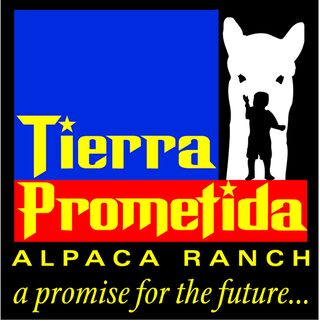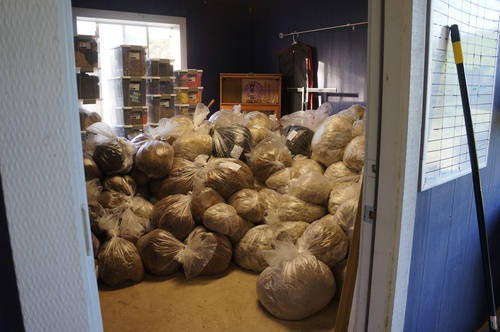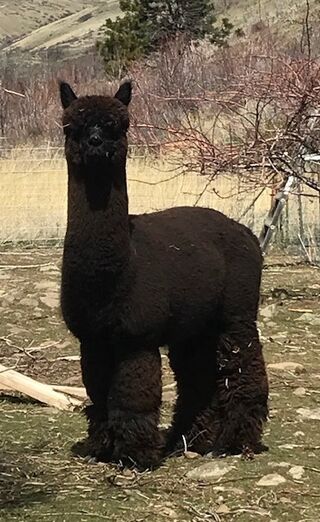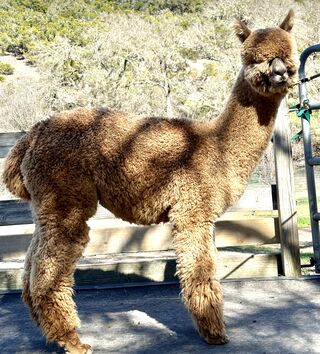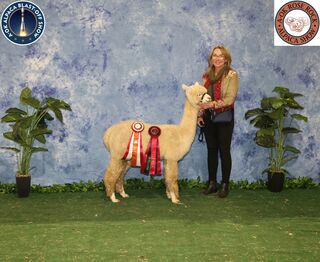Why Alpacas?
Monday, January 14, 2013
Like the old song says, with alpacas, to know them is to love them! We have never had a ranch visitor that left our ranch not wishing they could take some home. That being said, taking home livestock means accepting some degree of work and expense, and potential new owners always have a lot of questions. We are always ready to answer.
One of the most common questions asked about alpacas is “What do you do with them?”, and the corollary, “How can you make money doing this?”. Throughout the livestock industry, profits are made either by slaughtering the animal and selling products (meat, etc), by obtaining products from a live animal (eggs, milk, wool, etc), or by selling the offspring. The ultimate value of alpacas is in their unusually fine fleece, but there is also significant return on investment with selling offspring. The fleece is collected once a year, by shearing, which does not harm the alpaca in any way. Fleece weights vary from three to thirteen pounds. Depending on the quality of the fleece, it can be sold raw for $2-8 per pound, which admittedly covers only a few expenses in a small herd. Larger farms, some with 2000 alpacas or more, find the raw fiber to be profitable. However, smaller alpaca ranchers have learned how to multiply the value of the fiber by processing it into yarn, which usually sells for $40 a pound. There are nearby craftsmen that utilize the coarser parts of the fleece to make beautiful rugs with natural colors that are perfect with a Southwestern décor. The fiber succeeds because it is unequaled in softness, comfort, and durability and the demand is high. Alpaca can be worn next to the skin by the same people who become itchy wearing sheep’s wool.
Fleece production is the sustainable way for alpacas to pay their own way. However, some ranchers concentrate on the breeding side of the industry. Not every alpaca is breeding quality, but those that are command an enviable return on investment at auction. In the past, the prices were often unjustifiably high, and sometimes still are. Today, quality breeding alpacas will often be sold at auction for several thousand dollars. However, there is also a market for very nice alpacas, for pets or just for fiber producers, which are available at a fraction of that cost. The economy, and the increasing sophistication of buyers, has brought the prices down to the point that alpaca ownership is within reach for many land owners.
One of the most common questions asked about alpacas is “What do you do with them?”, and the corollary, “How can you make money doing this?”. Throughout the livestock industry, profits are made either by slaughtering the animal and selling products (meat, etc), by obtaining products from a live animal (eggs, milk, wool, etc), or by selling the offspring. The ultimate value of alpacas is in their unusually fine fleece, but there is also significant return on investment with selling offspring. The fleece is collected once a year, by shearing, which does not harm the alpaca in any way. Fleece weights vary from three to thirteen pounds. Depending on the quality of the fleece, it can be sold raw for $2-8 per pound, which admittedly covers only a few expenses in a small herd. Larger farms, some with 2000 alpacas or more, find the raw fiber to be profitable. However, smaller alpaca ranchers have learned how to multiply the value of the fiber by processing it into yarn, which usually sells for $40 a pound. There are nearby craftsmen that utilize the coarser parts of the fleece to make beautiful rugs with natural colors that are perfect with a Southwestern décor. The fiber succeeds because it is unequaled in softness, comfort, and durability and the demand is high. Alpaca can be worn next to the skin by the same people who become itchy wearing sheep’s wool.
Fleece production is the sustainable way for alpacas to pay their own way. However, some ranchers concentrate on the breeding side of the industry. Not every alpaca is breeding quality, but those that are command an enviable return on investment at auction. In the past, the prices were often unjustifiably high, and sometimes still are. Today, quality breeding alpacas will often be sold at auction for several thousand dollars. However, there is also a market for very nice alpacas, for pets or just for fiber producers, which are available at a fraction of that cost. The economy, and the increasing sophistication of buyers, has brought the prices down to the point that alpaca ownership is within reach for many land owners.
